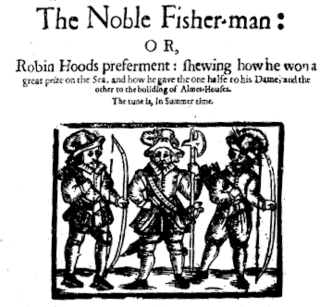Related Research Articles

Robin Hood is a legendary heroic outlaw originally depicted in English folklore and subsequently featured in literature and film. According to legend, he was a highly skilled archer and swordsman. In some versions of the legend, he is depicted as being of noble birth, and in modern retellings he is sometimes depicted as having fought in the Crusades before returning to England to find his lands taken by the Sheriff. In the oldest known versions, he is instead a member of the yeoman class. Traditionally depicted dressed in Lincoln green, he is said to have robbed from the rich and given to the poor.

Sir Guy of Gisbourne is a character from the Robin Hood legends of English folklore. He first appears in "Robin Hood and Guy of Gisborne", where he is an assassin who attempts to kill Robin Hood but is killed by him. In later depictions, he has become a romantic rival to Robin Hood for Maid Marian's love.

The Merry Adventures of Robin Hood of Great Renown in Nottinghamshire is an 1883 novel by the American illustrator and writer Howard Pyle. Pyle compiled the traditional Robin Hood ballads as a series of episodes of a coherent narrative. For his characters' dialog, Pyle adapted the late Middle English of the ballads into a dialect suitable for children.
Richard at the Lee is a major character in the early medieval ballads of Robin Hood, especially the lengthy ballad A Gest of Robyn Hode, and has reappeared in Robin Hood tales throughout the centuries.
"Robin Hood and the Curtal Friar" is Child Ballad number 123, about Robin Hood.
"Robin Hood's Progress to Nottingham" is Child ballad 139, an original story that is part of the Robin Hood canon. This song has survived as, among other forms, a late 17th-century English broadside ballad, and is one of several ballads about the medieval folk hero that form part of the Child ballad collection, which is one of the most comprehensive collections of traditional English ballads.

Robin Hood's Death, also known as Robin Hoode his Death, is an Early Modern English ballad of Robin Hood. It dates from at the latest the 17th century, and possibly originating earlier, making it one of the oldest existing tales of Robin Hood. It is a longer version of the last six stanzas of A Gest of Robyn Hode, suggesting that one of the authors was familiar with the other work and made an expansion or summary of the other, or else both were drawing from a lost common tale. The surviving version in the Percy Folio is fragmentary, with sections missing. A more complete but later version is from the middle of the 18th century, and is written in modern English. Both versions were later published by Francis James Child as Child ballad #120 in his influential collection of popular ballads.
Robin Hood and the Tanner is Child ballad 126. It is a late seventeenth-century English broadside ballad and one of several ballads about the medieval folk hero Robin Hood that form part of the Child ballad collection, which is one of the most comprehensive collections of traditional English ballads but has now been subsumed and surpassed by the Roud Folk Song Index.

Robin Hood and the Potter is a 15th century ballad of Robin Hood. While usually classed with other Robin Hood ballads, it does not appear to have originally been intended to be sung, but rather recited by a minstrel, and thus is closer to a poem. It is one of the very oldest pieces of the surviving Robin Hood legend, with perhaps only Robin Hood and the Monk older than it. It inspired a short play intended for use in May Day games, attested to around 1560. It was later published by Francis James Child as Child ballad #121 in his influential collection of popular ballads in the 1880s.
Robin Hood and the Butcher is a story in the Robin Hood canon which has survived as, among other forms, a late seventeenth-century English broadside ballad, and is one of several ballads about the medieval folk hero that form part of the Child ballad collection, which is one of the most comprehensive collections of traditional English ballads. It may have been derived from the similar Robin Hood and the Potter.
Robin Hood and the Valiant Knight is an 18th century ballad of the death of Robin Hood. The song, written in Modern English, was included in the popular "garlands" (collections) of Robin Hood stories and songs published in the 18th and early 19th centuries, generally at the end as a suitable close to the garland. It was later published by Francis James Child as Child ballad #153 in his influential collection of popular ballads.
Robin Hood's Delight is Child ballad 136. It is a story in the Robin Hood canon which has survived as, among other forms, a late seventeenth-century English broadside ballad, and is one of several ballads about the medieval folk hero that form part of the Child ballad collection, which is one of the most comprehensive collections of traditional English ballads.

A Gest of Robyn Hode is one of the earliest surviving texts of the Robin Hood tales. Written in late Middle English poetic verse, it is an early example of an English language ballad, in which the verses are grouped in quatrains with an ABCB rhyme scheme, also known as ballad stanzas. Gest, which means tale or adventure, is a compilation of various Robin Hood tales, arranged as a sequence of adventures involving the yeoman outlaws Robin Hood and Little John, the poor knight Sir Richard at the Lee, the greedy abbot of St Mary's Abbey, the villainous Sheriff of Nottingham, and King Edward of England. The work survives in printed editions from the early 16th century, just some 30 years after the first printing press was brought to England. Its popularity is proven by the fact that portions of more than ten 16th- and 17th-century printed editions have been preserved. While the oldest surviving copies are from the early 1500s, many scholars believe that based on the style of writing, the work likely dates to the 1400s, perhaps even as early as 1400. The story itself is set somewhere from 1272 to 1483, during the reign of a King Edward; this contrasts with later works, which generally placed Robin Hood earlier in 1189–1216, during the reigns of King Richard and King John.
Robin Hood and the Bishop is number 143 in Francis James Child's collection of Child ballads, and describes an adventure of Robin Hood. This song has also survived as a late seventeenth-century English broadside ballad, and is one of several ballads about the medieval folk hero that form part of the Child ballad collection, which is one of the most comprehensive collections of traditional English ballads.

The Noble Fisherman, also known as Robin Hood's Preferment and Robin Hood's Fishing, is a 17th-century ballad of Robin Hood. Unusually, it depicts Robin Hood as a hero of the sea, rather than his usual portrayal as someone who operated in the greenwood forest. It seems to have been quite popular for the first two centuries of its existence, although it eventually lost prominence and was less used in adaptations of Robin Hood from the 19th and 20th centuries. It was later published by Francis James Child in the 1880s as Child Ballad #148 in his influential collection of popular ballads.

Robin Hood and the Monk is a Middle English ballad and one of the oldest surviving ballads of Robin Hood. The earliest surviving document with the work is from around 1450, and it may have been composed even earlier in the 15th century. It is also one of the longest ballads at around 2,700 words. It is considered one of the best of the original ballads of Robin Hood.
Robin Hood and the Shepherd is a story in the Robin Hood canon which has survived as, among other forms, a late seventeenth-century English broadside ballad, and is one (#135) out of several ballads about the medieval folk hero that form part of the Child ballad collection, which is one of the most comprehensive collections of traditional English ballads.

The Tale of Gamelyn is a romance written in c. 1350 in a dialect of Middle English, considered part of the Matter of England. It is presented in a style of rhymed couplets and described by Skeat as "the older and longer kind of ballad" and by Ramsey as a "rough and ready romance."

Robin Hood and Little John is Child ballad 125. It is a story in the Robin Hood canon which has survived as, among other forms, a late seventeenth-century English broadside ballad, and is one of several ballads about the medieval folk hero that form part of the Child ballad collection, which is one of the most comprehensive collections of traditional English ballads.
The Forresters Manuscript is a quarto book of 21 English Robin Hood ballads, believed to have been written sometime in the 1670s. It's named the Forresters Manuscript after the first and last ballads in the book, which are both titled in the book, Robin Hood and the Forresters.This manuscript remained undiscovered and unknown for over 300 years after it was written until it turned up at an auction house in 1993, where it was found by the Bristol bookseller A. R. Heath, sold to the London book-dealer Bernard Quaritch Ltd., and then came to rest in the British Library. It was then published for the first time in 1998 as Robin Hood: The Forresters Manuscript, edited by Stephen Knight.
References
- 1 2 Child, Francis, ed. (1888). The English and Scottish popular ballads. Vol. 3. Cambridge: The Riverside Press. pp. 12–14.
- ↑ Dixon-Kennedy, Mike (2006). The Robin Hood Handbook. Sutton Publishing. p. 381. ISBN 0-7509-3977-X.
- 1 2 3 4 5 6 Dobson, R. B.; Taylor, J. (1997) [1976]. Rymes of Robin Hood. Sutton. pp. 7–8, 255–257. ISBN 0 7509 1661 3.
- 1 2 Knight, Stephen; Ohlgren, Thomas H., eds. (2000). "Robyn and Gandelyn: Introduction". Robin Hood and Other Outlaw Tales. University of Rochester.
- ↑ Holt, James Clarke (1989) [1983]. Robin Hood (Revised ed.). London: Thames and Hudson. pp. 71–73.